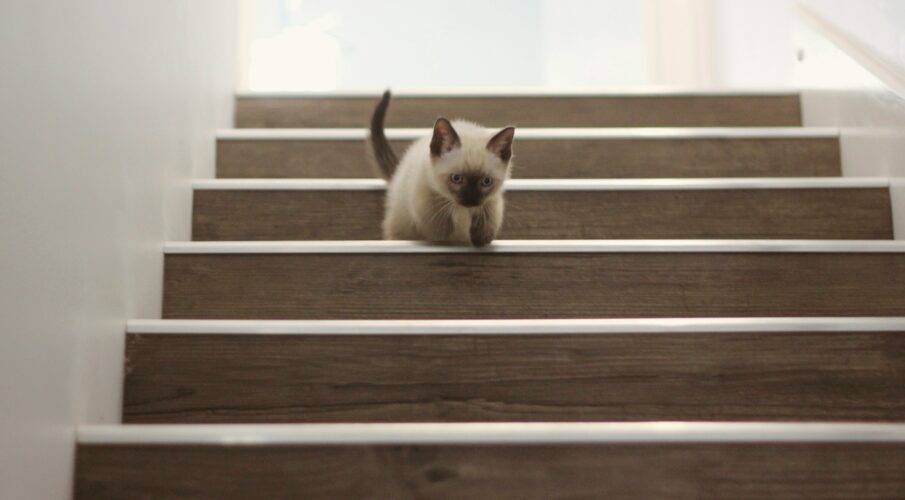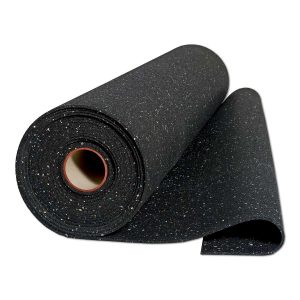Stairs are an underrated invention, aren’t they? A quick way to get up and down, they’ve been employed since at least people started making pyramids, and probably longer. But despite the fact that humans have been building stairs for literally thousands of years, they are still pretty noisy.
I remember living in an apartment once that was in a nice building with very nice units. The rent was reasonable and I was happy to live there, except for the godforsaken staircases. The care the construction company had put into the building seemed to end at the stairs, and all of the staircases that connected the floors and apts to one another creaked, groaned, and rang out whenever someone was stepping upon them. Even though they were outside my apt – through the door and down the hall – I could always hear when someone was on them. It was just part of living there. Now, after a career in acoustics, I’ve realized how simple a problem noisy stairs are to fix!
In this article, we’ll take a look at the general construction of stairs and the rather simple process of acoustically treating them so they are soundproof. Trust me, your tenants may never compliment you on the quiet stairs you installed, but you will be saved from countless complaints having not done so!
Why Stairs Tend to Be Noisy

Photo by Polly Alexandra on Unsplash
Interior stairs are almost always made of wood planks. The longer the staircase, the more planks there are, and the most chances for wood to squeak and groan. Typically, the planks used to make stair treads are from cheaper woods that may be thinner and noisier. Except for high-end luxury living, dense hardwoods are unlikely to be used. Even then, they can be noisy after a time or if uninstalled incorrectly. Regardless, just the sound of impact can be heard as someone traverses the stairs no matter the material.
Install issues, groans, creaks, wood types, impact sounds, etc… All of this can be avoided with three easy steps!
How to Soundproof Stair Treads in 3 Easy Steps
1. Check for Loose, Improperly Installed Boards
Stair tread soundproofing involves getting under the finished flooring, so it pays to make sure that the planks underneath are not damaged or improperly installed. Often this can be the cause of some of the acoustic issues, but since you’re planning to do this renovation right, it’s important to check for any issues and correct them before moving onto the application of soundproofing materials.
2. Apply Iso Step Floor Underlayment
Engineered to provide superior impact sound insulation, Iso-Step® Floor Underlayment can be installed over both wood and concrete to block footfall and structure-borne sound and vibration. Not only does impact energy create airborne sound, it also creates vibrations that work through the stair material and associated structure. To combat this, Iso-Step® Floor Underlayment is applied directly to the stair tread, underneath the finished flooring, in order to both block the airborne sounds of impact as well as vibrations that would move into the stair structure itself.
To get the most out of Iso-Step® Floor Underlayment, I suggest that my clients use Iso-Step® Soundproofing Underlayment Adhesive when laying the underlayment down. Not only does this secure the underlayment, but the adhesive is specifically designed with an Impact Insulation Class (IIC) and Sound Insulation Class (STC) ratings of 68 dD, in order to provide even more soundproofing. Offered in standard and Quick Cure, this adhesive pairs perfectly with the Iso-Step® Floor Underlayment and will be your shield against unwanted stair tread impact noise.
3. Install Finished Flooring
That’s it for soundproofing! Now with your Iso-Step® Floor Underlayment installed, the only task left is to cover the stair treads with your flooring of choice. While carpet has more acoustic insulative ability than wood flooring and laminate, now that the treads are properly soundproofed, even using these will not make a noticeable difference. Whether carpet, laminate, or actual wood, just be sure to properly cut and install the pieces so they fit tight and snug.
Silence Those Noisy Stairs with Acoustical Solutions
Three steps is pretty easy, right? From once creaky, groaning, noisy stairs to peace with a little bit of effort! If you have any further questions about soundproofing your stairs, or any other acoustical needs, please reach out to me today and I’d be happy to jump on a call and find you the perfect solution!
To learn more about how Acoustical Solutions can solve your noise control problems, use our contact form, call one of our Acoustical Sales Consultants at (800) 782-5742, or visit us on the web at acousticalsolutions.com.
